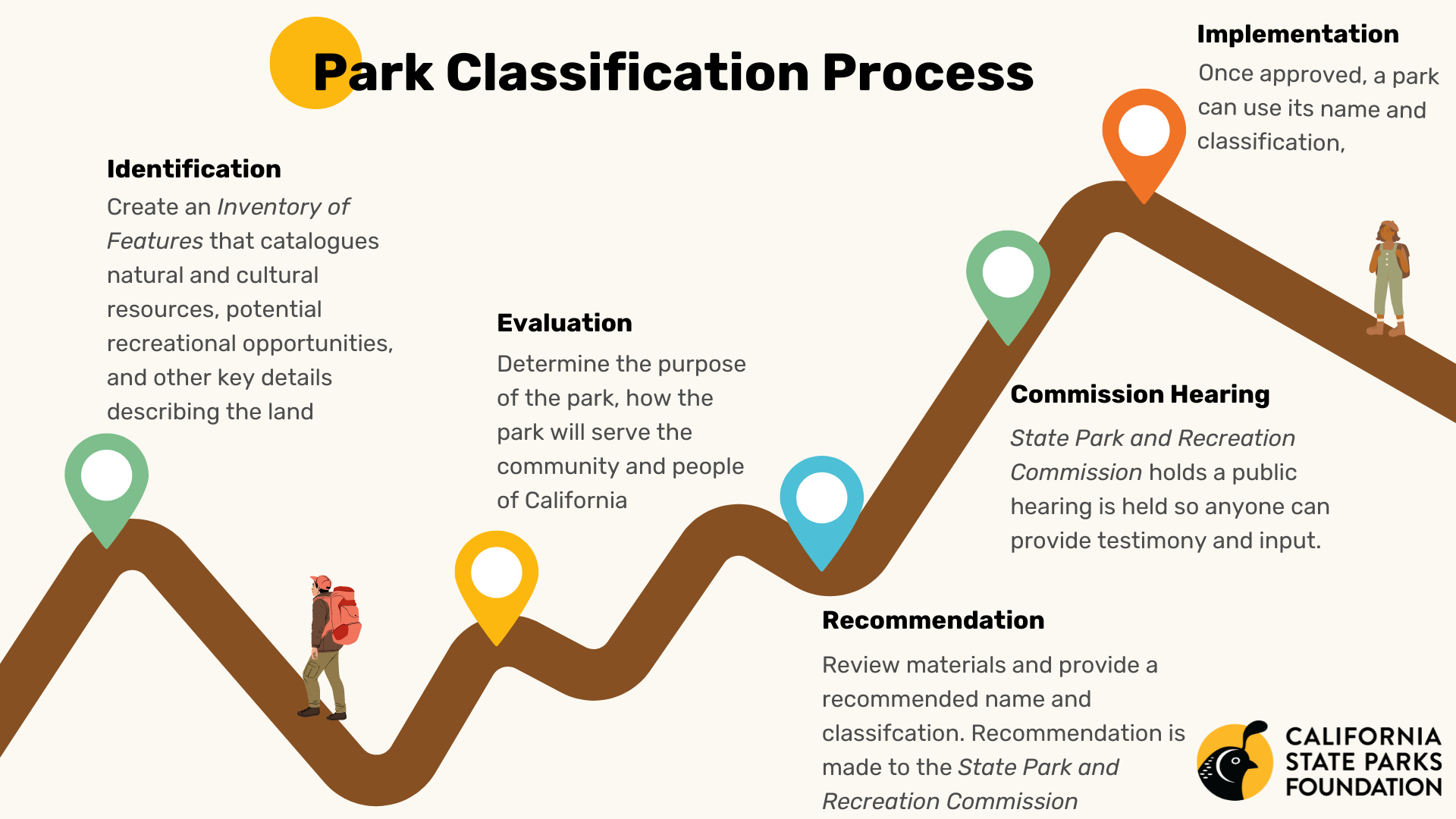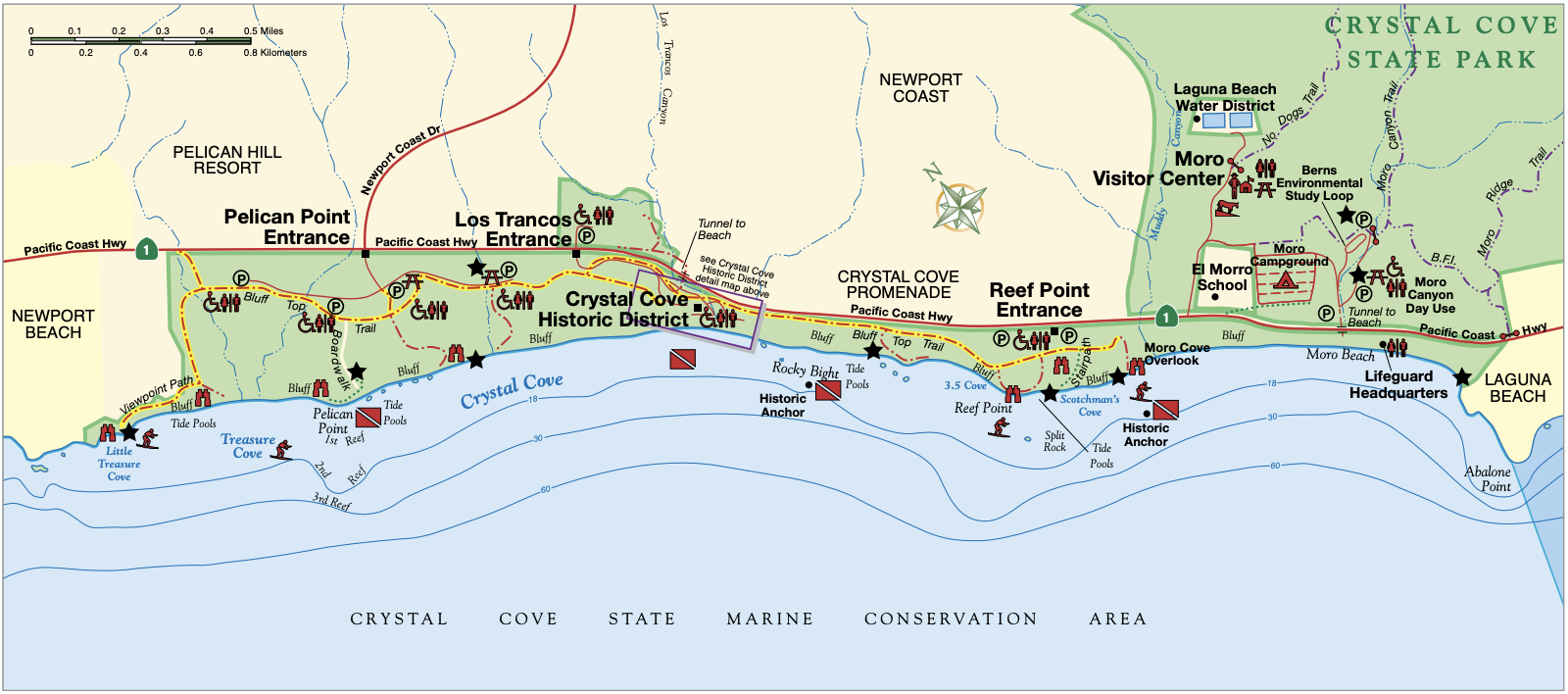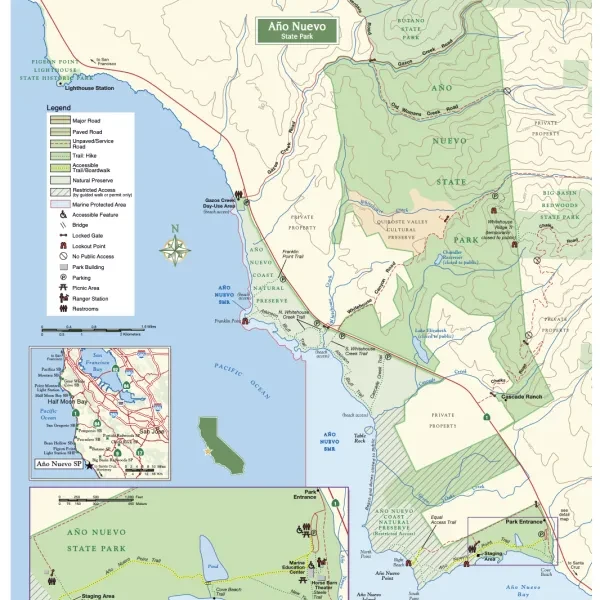California’s state parks comprise the largest and most diverse natural and cultural heritage holdings of any state in the nation. These protected areas are as diverse as the population of California. Visit one of the 280 parks and you may find wilderness, Indigenous peoples’ cultural preserves, lighthouses, ghost towns, endemic plants, and more.
Not all state parks go by the same name though. Park units in the California state park system, like many other park systems, use a classification system to categorize parks and communicate information about a park’s purpose, geography, and programming. Have you ever wondered about the difference between Monterey State Beach and Monterey State Historic Park? Or thought, “What the heck is a State Natural Reserve?” If so, you’re not alone. These names were set up as a guide for what to expect from a certain parkland, but it takes some time to learn which is which, so we created this cheat sheet for you to know the difference before you go!
Why do we classify park units?
Why don’t we call every park unit a State Park? Park units play different roles in both preservation and providing recreational opportunities depending on what is contained inside the park and how many services are offered for visitors. A park’s classification concisely indicates what a park’s purpose is. Does it exist to preserve something special, to provide opportunities to enjoy a recreational activity, or both? Park classification tells the public what they might expect to experience when visiting the park unit, and it also provides direction to park staff on key issues such as what interpretive programming to offer, what services and amenities (like campgrounds or picnic areas) can be built, and what type of recreational activities (like hiking, camping, or horseback riding) could be allowed.
How does a park receive its classification?
Although park units are different from each other, they are governed by the same park classification process.
Identification:
- California State Park staff perform on-site surveys, assessments, and studies to inventory significant natural, cultural, and recreational resources contained at a property. They look at how the land was historically used and what role it plays in the broader ecosystem. This information is summarized in a report called an Inventory of Features.
Evaluation:
- Once staff know more about what exists at the property they’re assessing, they must consider natural, cultural, recreational, and interpretive opportunities for the park.
- California State Parks staff might identify and discuss challenges, obstacles, or competing goals at this stage. Based on the information contained in the Inventory of Features, they will make decisions that weigh different goals, such as providing recreational opportunities and preserving cultural, historical, or natural resources.
Recommendation:
- A park district’s planning division will evaluate the information and analysis to recommend both a unit classification and a unit name.
- They might hold a public meeting to obtain input and feedback from communities and organizations with a vested interest in how the park is used.
- Park units are often given a name that they’ve already been called — either based on where they are located, what the land has been called historically, or what the unit is already commonly called. There may also be deed restrictions, easements, or naming requirements that were outlined when California State Parks acquired the land.
- Finally, the California State Parks Director reviews and approves the park name and unit classification and sends a proposal to the State Park & Recreation Commission.
Commission Hearing:
- The State Park & Recreation Commission holds a public Naming and Classification hearing to allow opportunities to provide testimony to the park name. Assuming all proceeds go as planned, the commission approves the park’s name and classification.
- P.S. Any marine unit needs California Fish and Game Commission to approve the classification as well!
Implementation:
- The park’s name and classification may now be used in places like the park website, maps, and brochures!
What are the different park classifications?
Each park unit classification gives information on a park’s purpose (why this area was selected for preservation) and what you can expect when you visit the park (such as what recreational opportunities or facilities might be provided at the site.)
State Park
- Purpose: Preserve outstanding examples of the natural, scenic, and cultural character of California while also providing opportunities for public enjoyment and education.
- What it is: The most flexible park unit designation, state parks allow both resource stewardship and recreational use to coexist as equal and interconnected goals. Because of this, state parks often contain a variety of facilities and amenities, including campgrounds and visitor centers.
State Recreation Area
- Purpose: Provide outdoor recreational opportunities to serve the needs of both local and state-wide communities.
- What it is: As the primary purpose is recreational, these parks are often close to large cities, major highways or roads, or on bodies of water where many people already travel. They are chosen because they’re able to accommodate and withstand large numbers of people visiting and taking part in outdoor activities there.
- State Recreation Areas may be subcategorized into State Beaches, Underwater Recreation Areas, and Wayside Campgrounds.
State Historical Unit
- Purpose: Preserve places, structures and artifacts of historical, archaeological and scientific importance.
- What it is: A park containing a piece of California’s history, often commemorating important people or events. Because the main goal is to preserve history, there are strict regulations about what can be built in these park units, so you will only find facilities that are required for visitor safety and comfort (like parking lots, bathrooms, and water). However, these sites often offer a wealth of interpretive programming to educate visitors on the history contained there. Additionally, you might be able to see or partake in historically accurate and relevant commercial activities — like agricultural practices or gold panning!
- State Historical Units may be subcategorized as State Historical Monuments.
- DID YOU KNOW? The State Historical Resources Commission is tasked with identifying and registering locations significant to California’s history and culture? This group nominates new entries to the National Register of Historic Places. To find lists of historic places in California, visit the Office of Historic Preservation.
State Seashore
- Purpose: Preserve coastal lands, with recreation provided as a secondary goal where possible.
- What it is: Lands on the coast of the ocean or a bay with outstanding scenic beauty or natural value. Because the first goal of a state seashore is land preservation, recreational opportunities might be more limited than at a state beach or a state park found on the coast.
State Natural Reserve
- Purpose: Preserve land with unique plants or animals, geological features, or scenic qualities to a “condition of undisturbed integrity.”
- What it is: Park units protecting unique plants or animals, some of which are endemic to those park units or the state of California. These park units often have very few facilities or amenities (like trails, parking lots, or bathrooms). As the goal of a natural reserve is to keep the ecosystem contained there as undisturbed as possible, fewer recreational activities might be allowed there.
State Cultural Reserve
- Purpose: Preserve areas of historic or prehistoric significance that are important to understanding historic humans or cultures or are of spiritual significance to Indigenous peoples.
- What it is: These park units contain historic sites such as structures, villages, archaeological features, ruins, artifacts, inscriptions made by humans, burial grounds, landscapes and hunting or gathering sites. Resources contained in these park units are protected highly but may be used by Indigenous people and groups for ceremonial or spiritual purposes.
State Wilderness
- Purpose: Preserve wild land that has not been modified by humans so it’s “unimpaired for future use and enjoyment as wilderness.” Wilderness means that humans are only visitors in these places, not permanent residents.
- What it is: At least 5,000 acres of land, often within the boundaries of other state park units, that has very little manmade features such as trails, bathrooms, campgrounds, and buildings.
State Marine Area
- Purpose: Conserve biological diversity and marine habitats, provide a sanctuary for marine life, and enhance recreational, educational, and scientific research opportunities. Marine areas are managed (or co-managed) by the California Department of Fish and Wildlife. The official designation of marine areas is that these protected areas have to be “seaward of the mean high tide line” which explains why many are near protected park units like state beaches or state parks.
- What it is: Protected ocean waters, reefs, and underwater areas. Many marine areas offer opportunities to swim, dive, observe wildlife, and fish recreationally.
- More information, including regulations and safety guidance, is available from the California Department of Fish and Wildlife.
State Vehicular Recreation Area
- Purpose: Provide recreational opportunities specifically intended to be used by off-highway vehicles (OHV). These areas are managed by the OHMVR Division of California State Parks.
- What it is: A park with maintained OHV trails or tracks that provide OHV recreation opportunities while enhancing wildlife habitat, erosion control and revegetation.
- More information, including regulations and safety guidance, is available from the OHMVR Division of California State Parks.


